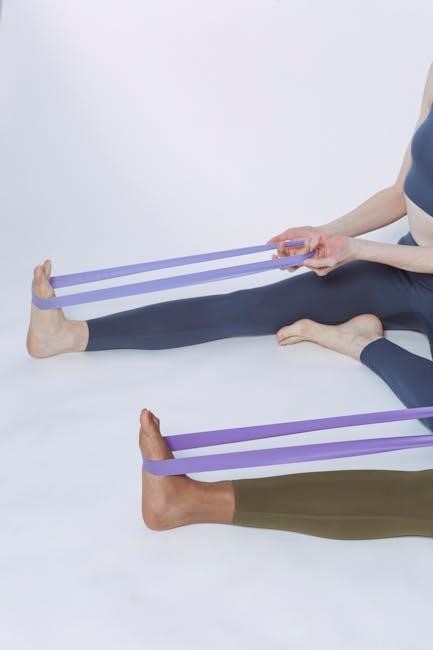
resistance band core exercises pdf
Resistance band core exercises offer a versatile and effective way to strengthen abdominal muscles. Portable and adaptable, they target multiple muscle groups, enhancing stability and overall core strength. Perfect for home workouts, these exercises provide a comprehensive routine to improve posture, balance, and athletic performance. With a downloadable PDF guide, you can access detailed instructions and exercises to maximize your core training efficiently.
Why Resistance Bands Are Effective for Core Training
Resistance bands are highly effective for core training due to their versatility and ability to engage multiple muscle groups simultaneously. Unlike traditional weights, resistance bands provide continuous tension throughout exercises, which enhances muscle activation and endurance. They are lightweight and portable, making them ideal for home workouts or travel. The bands also allow for dynamic movements that mimic real-life actions, improving functional strength and stability. Additionally, resistance bands can target both stabilizer and primary muscles, ensuring a comprehensive core workout. Their adjustable resistance levels cater to all fitness levels, from beginners to advanced athletes, making them a valuable tool for building a strong and resilient core.
Benefits of Using Resistance Bands for Home Workouts
Resistance bands offer numerous advantages for home workouts, making them an excellent choice for core training. They are lightweight, portable, and require minimal storage space, ideal for small living areas. Their affordability compared to gym equipment makes them accessible to everyone. Bands provide versatile workouts, targeting multiple muscle groups simultaneously, which is perfect for full-body exercises. They are also low-impact, reducing joint strain, and can be easily adjusted to suit different fitness levels. Additionally, resistance bands allow for progressive overload, enabling users to increase intensity as they gain strength. Their convenience and effectiveness make them a practical and efficient tool for achieving a strong, stable core from the comfort of home.
Understanding the Core Muscles
The core includes abdominals, obliques, lower back muscles, and the diaphragm, working together to stabilize the body and enable movement. Strengthening these muscles improves posture and functional strength.
Major Core Muscle Groups and Their Functions
The core comprises several key muscle groups, each serving distinct roles. The abdominals, including the rectus abdominis and transverse abdominis, support the pelvis and spine while enabling flexion and stabilization. The obliques, both internal and external, facilitate rotational movements and lateral flexion. The erector spinae and latissimus dorsi in the lower back contribute to posture, extension, and rotational movements. These muscles work synergistically to provide stability, generate power, and maintain proper posture. Understanding their functions is crucial for designing effective resistance band exercises that target specific areas, ensuring balanced core development and enhancing overall athletic performance and daily functionality.
How Resistance Bands Target the Core
Resistance bands effectively target the core by providing continuous tension throughout exercises, engaging both stabilizing and moving muscles. They work in multiple planes of motion, challenging the abdominals, obliques, and lower back muscles. For example, exercises like banded pallof presses and Russian twists require rotational strength, activating the obliques, while movements like plank rows engage the transverse abdominis for stability. The bands’ elastic resistance increases with movement, forcing the core to work harder to maintain control. This versatility allows for exercises that isolate specific muscle groups or integrate multiple core muscles simultaneously, enhancing both stability and dynamic strength. This makes resistance bands a versatile tool for comprehensive core development.
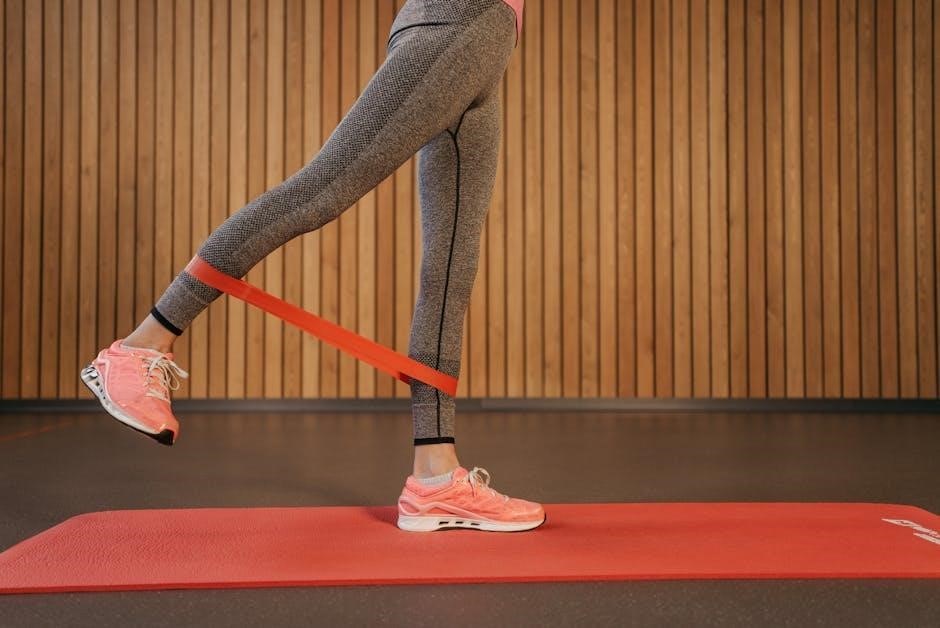
Top Resistance Band Core Exercises
These effective and versatile exercises engage the entire core through dynamic movements like crunches, twists, and stabilizations, perfect for both beginners and advanced users.
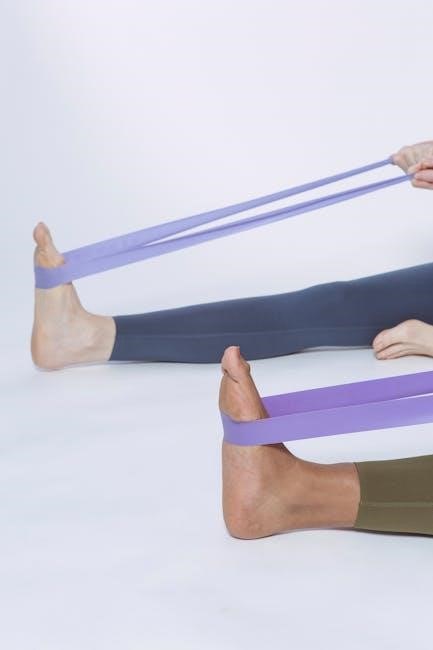
Banded Plank Row
The banded plank row is an excellent exercise for engaging the core, shoulders, and back muscles. Start in a plank position with a resistance band looped around a stable anchor point. Grip the band with both hands, keeping your arms extended and your body in a straight line. Engage your core, pull the band toward your chest, and hold for a brief moment before slowly releasing back to the starting position. This exercise targets the rhomboids, latissimus dorsi, and transverse abdominis muscles, improving posture and overall core stability. Focus on maintaining a neutral spine and avoid rounding your shoulders during the movement.
Resistance Band Pallof Press
The resistance band Pallof press is a dynamic exercise that strengthens the obliques and improves rotational strength. To perform this exercise, anchor the resistance band at chest height and stand sideways to the anchor point. Grip the band with both hands and press it away from your body, keeping your arms straight. Maintain a neutral spine and engage your core to resist the band’s pull. Focus on slow, controlled movements to maximize muscle activation. This exercise enhances rotational stability and targets the obliques effectively. It’s ideal for improving functional strength and preventing injuries. Keep your movements precise to avoid using momentum and ensure proper engagement of the core muscles throughout the exercise.
Banded Russian Twists
Banded Russian twists target the obliques, enhancing rotational strength and core stability. Sit on the floor with knees bent, looping the resistance band around a stable object behind you. Grip the band with both hands, keeping your spine neutral and feet lifted slightly. Twist your torso to one side, pulling the band toward your chest, then return to center and repeat on the other side. Focus on controlled movements to avoid using momentum; This exercise strengthens the obliques and improves rotational power, which is essential for sports and daily activities. Maintain proper form by engaging your core and keeping your chest upright throughout the movement.
Standing Banded Cable Crunch
The standing banded cable crunch is an effective exercise for targeting the abdominal muscles. Anchor the resistance band at shoulder height and hold both ends, standing facing away from the anchor point. Engage your core, maintain a neutral spine, and crunch downward, bringing your elbows toward your knees. Keep the movement controlled, avoiding excessive arching of the back. This exercise strengthens the rectus abdominis and improves core flexibility. It’s ideal for those who prefer a standing option over traditional floor crunches. Focus on slow, deliberate movements to maximize muscle engagement and minimize strain on the lower back. This exercise is versatile and can be adjusted by changing the resistance level.
Banded Leg Raises
The banded leg raise is a dynamic exercise that targets the lower abdominal muscles, enhancing core strength and flexibility. To perform this exercise, anchor the resistance band at a low point, such as the bottom of a door or a stable object. Lie on your back, securing the band under your feet or around your ankles. Slowly lift your legs straight up, keeping them together, while maintaining tension in the band. Avoid jerking movements to ensure controlled engagement of the abdominals. Lower your legs gradually to the starting position, maintaining constant resistance. This exercise is excellent for isolating the lower abs and improving overall core stability. It’s also adaptable to different fitness levels by adjusting the band’s resistance. Regular practice can enhance posture and reduce lower back strain.
Resistance Band Bird Dog
The Resistance Band Bird Dog is an excellent exercise for improving core stability, balance, and overall coordination. Begin by anchoring the resistance band at hip height to a stable object. Kneel on the floor, holding the other end of the band in both hands. Extend one arm and the opposite leg simultaneously, maintaining a straight line from head to heel. Keep your core engaged to maintain balance. Slowly return to the starting position and repeat with the opposite arm and leg. This exercise strengthens the transverse abdominis muscle, enhances posture, and improves functional movement patterns. It’s a great addition to any core workout for building stability and control. Regular practice can also enhance athletic performance and reduce injury risk.
Seated Banded Abdominal Crunch
The Seated Banded Abdominal Crunch is a highly effective exercise for targeting the abdominal muscles. Sit on the floor with your knees bent and feet flat. Loop the resistance band around a sturdy anchor point behind you, holding the ends in each hand at shoulder height. Engage your core, press your chest slightly forward, and perform a crunching motion, pulling the band towards your knees. Focus on controlled movements to avoid strain. This exercise strengthens the rectus abdominis and obliques while improving core engagement. It’s a versatile option for home workouts and can be modified to suit different fitness levels. Proper form ensures maximum effectiveness and safety.
Banded Side Bends
The Banded Side Bends exercise targets the obliques, essential for a strong and defined core. Stand tall with your feet shoulder-width apart, holding the resistance band under your shoulders. Grip the band firmly and bend sideways, stretching the band while keeping your arms straight. Alternate sides with controlled movements, focusing on engaging your obliques. This exercise improves lateral flexibility and strengthens the muscles responsible for rotational movements. It’s an excellent addition to any core routine, enhancing functional strength and posture. Adjust the resistance level based on your fitness goals and ensure proper form to avoid injury. Banded Side Bends are versatile and effective for all fitness levels, making them a great option for home workouts.
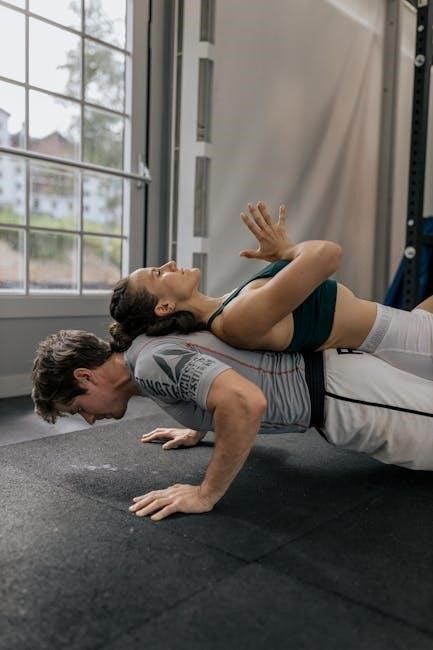
Proper Form and Safety Tips
- Maintain a neutral spine to prevent injury and maximize core engagement.
- Ensure the resistance band is anchored securely to avoid snapping.
- Focus on controlled movements and avoid jerking or bouncing.
- Breathe naturally, exhaling during the exertion phase of exercises.
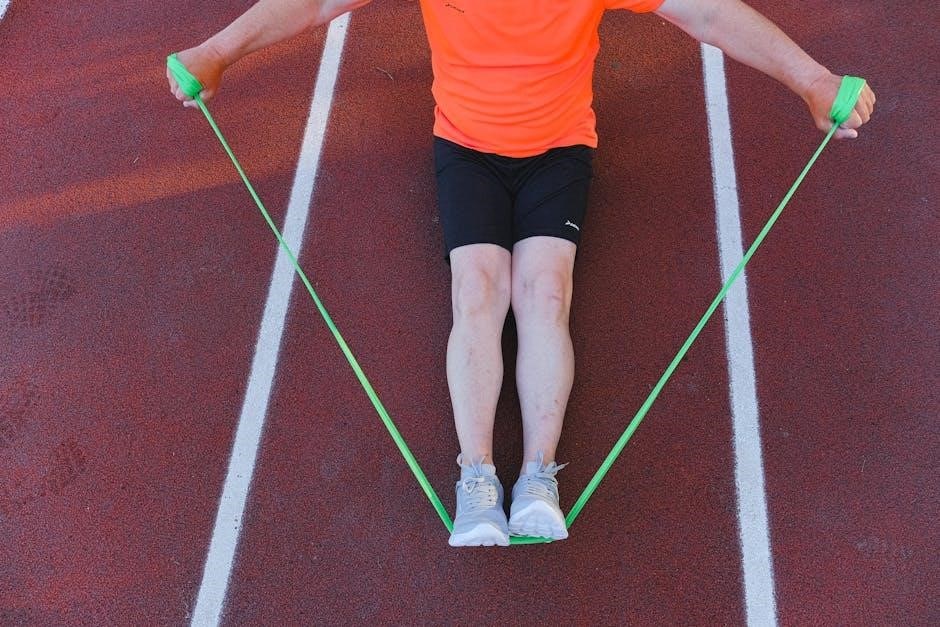
Importance of Maintaining a Neutral Spine
Maintaining a neutral spine during resistance band core exercises is crucial for preventing injuries and ensuring effective muscle engagement. A neutral spine refers to the natural alignment of the spine, avoiding excessive arching or rounding. Proper spinal alignment distributes force evenly, reducing strain on the lower back and promoting safe movement patterns. When the spine is neutral, core muscles like the abdominals and obliques can engage more effectively, enhancing the workout’s efficiency. Additionally, maintaining a neutral spine helps improve posture and reduces the risk of long-term back pain. Always prioritize spinal awareness to maximize the benefits of your resistance band exercises while minimizing potential harm.
How to Anchor the Resistance Band Safely
Properly anchoring a resistance band is essential for safety and effectiveness during core exercises. Choose a sturdy, immovable object like a door, column, or heavy piece of furniture to secure the band. Ensure the anchor point is at a comfortable height to avoid overreaching or awkward positioning. When using a door anchor, place the band at the top or bottom of the door and close it firmly to prevent movement. Always test the anchor’s stability before starting the exercise. Adjust the band’s length to maintain tension without overstretching. Avoid anchoring to objects that could shift or break, as this may cause accidents. Keep the band away from your face and ensure it is free from knots or twists for smooth movement.
Breathing Techniques for Effective Core Engagement
Proper breathing is crucial for effective core engagement during resistance band exercises. Inhale deeply before starting a movement to prepare your core, then exhale slowly as you perform the exercise. This pattern helps stabilize your spine and maintain intra-abdominal pressure. Focus on natural, rhythmic breathing to avoid holding your breath, which can increase pressure and reduce effectiveness. Engage your diaphragm by drawing air into your lower lungs, allowing your belly to rise slightly with each inhale. Exhale fully during the most challenging part of the movement to maximize core activation. Consistent, controlled breathing enhances strength, stability, and overall performance in resistance band core exercises.
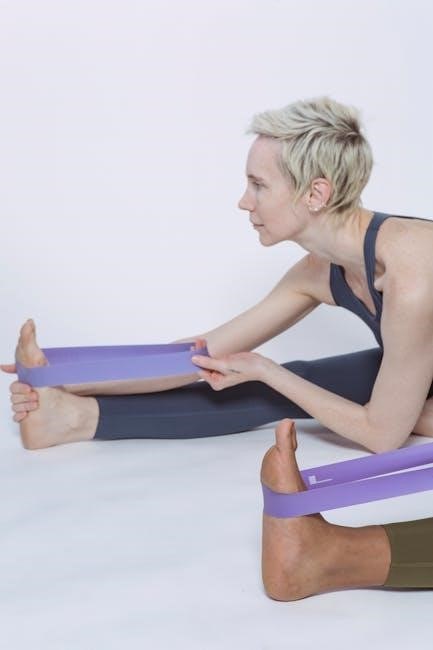
Creating a Core Workout Routine
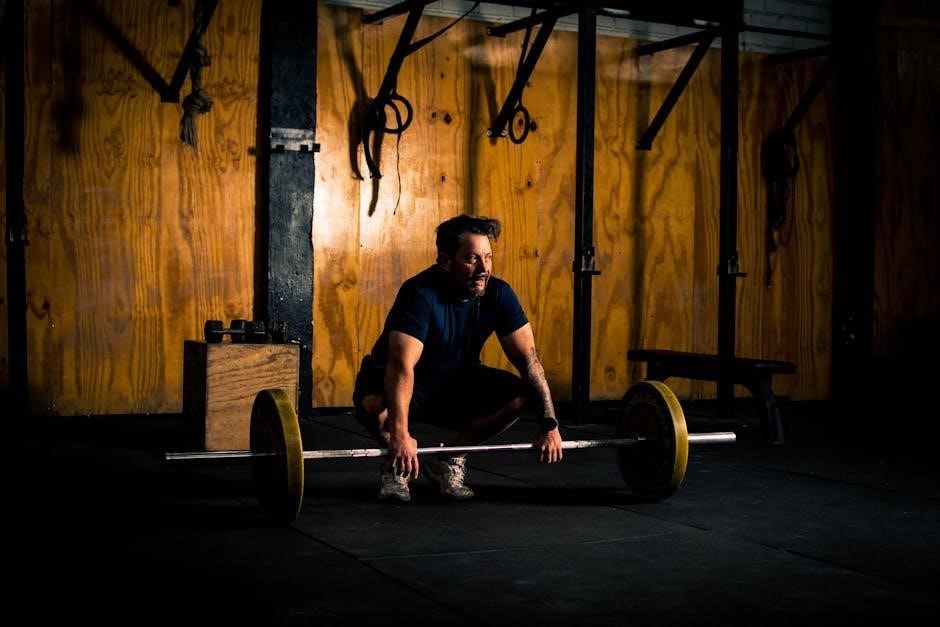
A well-rounded core workout routine should include essential exercises, vary resistance levels, and target all muscle groups. Focus on consistency and gradual progression for optimal results.
Structuring a Full-Body Core Workout
Structuring a full-body core workout involves combining exercises that target the abdominals, obliques, lower back, and stabilizing muscles. Start with compound movements like banded plank rows or Pallof presses to engage multiple muscle groups simultaneously. Incorporate dynamic exercises such as banded Russian twists and cable crunches to enhance rotational strength and stability. Alternate between upper body-focused and lower body-focused exercises to maintain balance. Finish with isometric holds, such as banded planks, to improve endurance. Aim for 3-4 sets of 12-15 reps per exercise, adjusting resistance and reps based on fitness level. Incorporate rest periods and progressively increase intensity over time for sustained progress and overall core development.
Setting Up a Progressive Resistance Program
Setting up a progressive resistance program with resistance bands involves gradually increasing the challenge to your muscles over time. Start by using lighter resistance bands and focus on mastering proper form. As strength improves, switch to thicker bands or combine multiple bands for added tension. Incorporate variations in exercise angles or ranges of motion to target muscles differently. Increase the number of repetitions, sets, or intensity over weeks to avoid plateaus. Track progress by noting improvements in reps or resistance levels. Allow 48-72 hours of rest between core workouts to ensure muscle recovery. Consistency and gradual progression are key to achieving long-term strength gains and core stability.
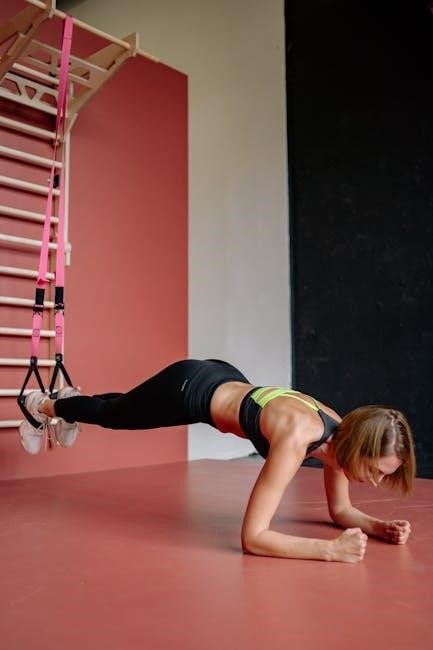
Additional Benefits of Resistance Band Training
Resistance bands improve flexibility, mobility, and functional strength. They are lightweight, portable, and cost-effective, making them ideal for full-body workouts anywhere. They also enhance coordination and balance.
Improving Flexibility and Mobility
Resistance bands are excellent for enhancing flexibility and mobility due to their ability to provide continuous tension throughout exercises. They allow for dynamic stretching and controlled movements, which help increase range of motion. Unlike static stretches, resistance bands engage muscles actively, promoting better flexibility while strengthening. Regular use improves joint mobility, making it easier to perform daily activities and athletic movements. Bands are versatile and can be used for exercises like banded leg swings, chest opens, or shoulder rotations. This makes them ideal for people of all fitness levels, from beginners to athletes, seeking to improve flexibility and reduce stiffness. Incorporating resistance bands into your routine enhances mobility and reduces injury risk.
Enhancing Functional Strength
Resistance bands are a powerful tool for building functional strength, which is essential for daily activities and athletic performance. Unlike traditional weights, bands provide variable resistance, challenging muscles through multiple planes of motion. This engages stabilizer muscles, improving coordination and balance. Exercises like banded Pallof presses and bird dogs strengthen the core and promote better movement patterns. Functional strength also enhances posture, reduces injury risk, and boosts overall physical resilience. By mimicking real-life movements, resistance bands help develop practical strength that translates to everyday tasks and sports. Incorporating them into your routine fosters a stronger, more capable body for both performance and daily life.
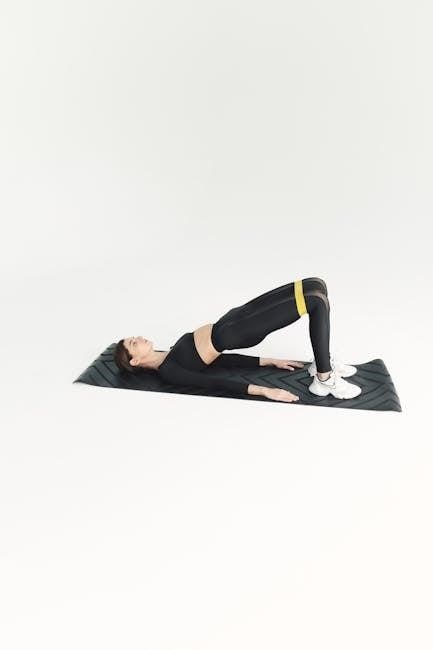
Downloadable PDF Guide

Access the free Resistance Band Core Exercises PDF by visiting our website and subscribing to our newsletter. Follow the link provided in your confirmation email to download your guide instantly.
How to Access the Free Resistance Band Core Exercises PDF
To access the free Resistance Band Core Exercises PDF, visit our official website and navigate to the “Resources” section. Click on the “Download Now” button to subscribe to our newsletter. You will receive a confirmation email with a direct link to download the guide. This comprehensive PDF includes detailed step-by-step instructions, high-quality images, and tips for mastering each exercise. Perfect for home workouts, it covers everything from beginner-friendly moves to advanced routines. Download your copy today and start building a stronger, more stable core with resistance bands!
The guide is entirely free and requires only a valid email address for delivery. Once downloaded, you can print or save it for easy reference during your workouts.


Leave a Reply
You must be logged in to post a comment.